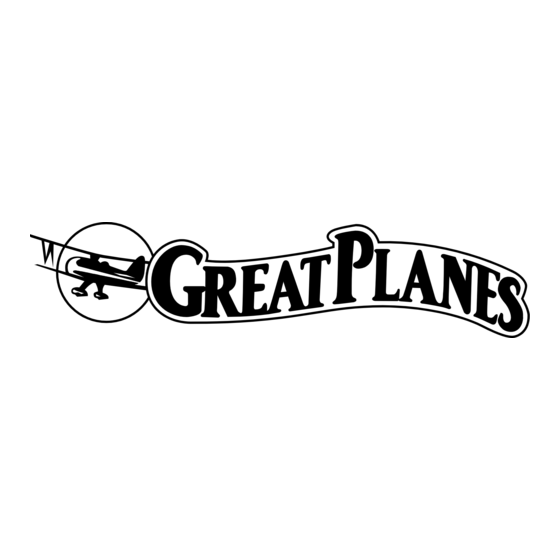GREAT PLANES Riot 3D Instruction Manual - Page 18
Browse online or download pdf Instruction Manual for Toy GREAT PLANES Riot 3D. GREAT PLANES Riot 3D 20 pages.

For reassurance and to keep an eye on other traffic, it is a
good idea to have an assistant on the flight line with you. Tell
him to remind you to throttle back once the plane gets to a
comfortable altitude. While full throttle is usually desirable for
takeoff, most models fly more smoothly at reduced speeds.
Take it easy with the Riot 3D ARF for the first few flights,
gradually getting acquainted with it as you gain confidence.
Adjust the trims to maintain straight and level flight. After
flying around for a while, and while still at a safe altitude with
plenty of battery power remaining, practice slow flight and
execute practice landing approaches by reducing the throttle
to see how the model handles at slower speeds. Add power
to see how it climbs as well. Continue to fly around,
executing various maneuvers and making mental notes (or
having your assistant write them down) of what trim or C.G.
changes may be required to fine-tune the model so it flies
the way you like. Mind your battery level, but use this first
flight to become familiar with your model before landing.
To initiate a landing approach, lower the throttle while on the
downwind leg. Allow the nose of the model to pitch
downward to gradually bleed off altitude. Continue to lose
altitude, but maintain airspeed by keeping the nose down as
you turn onto the crosswind leg. Make your final turn toward
the landing area (into the wind) keeping the nose down to
maintain airspeed and control. Level the attitude when the
model reaches an altitude of about 10 feet, modulating the
throttle as necessary to maintain your glide path and
airspeed. If you are going to overshoot, smoothly advance
the throttle (always ready on the right rudder to counteract
torque) and climb out to make another attempt. When you're
ready to make your landing flare and the model is a foot or
so off the deck, cut your throttle and smoothly increase up
elevator until it gently touches down on its belly. Make sure
that you cut your power completely before touchdown, or
propeller damage may result.
One final note about flying your model. Have a goal or flight
plan in mind for every flight. This can be learning a new
maneuver(s), improving a maneuver(s) you already know, or
learning how the model behaves in certain conditions (such
as on high or low rates). This is not necessarily to improve
your skills (though it is never a bad idea!) , but more
importantly so you do not surprise yourself by impulsively
attempting a maneuver and suddenly finding that you've run
out of time, altitude or airspeed. Every maneuver should be
deliberate, not impulsive. For example, if you're going to do
a loop, check your altitude, mind the wind direction
(anticipating rudder corrections that will be required to
maintain heading), remember to throttle back at the top, and
make certain you are on the desired rates (high/low rates).
A flight plan greatly reduces the chances of crashing your
model just because of poor planning and impulsive moves.
Remember to think.
Flight
Landing
Have a ball! But always stay in control and fly in a
safe manner.
GOOD LUCK AND GREAT FLYING!
Make a copy of this identification tag and put it on or
inside your model.
OTHER ITEMS AVAILABLE FROM
GREAT PLANES
ElectriFly FlatOuts
™
Go end-over-end with ease! If you're looking for tumbling
fun, the FlatOuts Reflection is your plane. Waterfalls,
tumbles, and rolls are amazingly easy. With its short
wingspan and large ailerons, the roll rate is incredible. Flight-
ready in only 2-3 hours, the Reflection includes a T-370
brushed motor with gearbox and slow-fly prop (and is also
available in a version without them, GPMA1140). Using the
supplied custom hardware and foam-safe CA, you'll easily
assemble its colorful foam panels and carbon rods into a
strong, eye-catching model that offers big returns in
performance for very little time and money.
18
Reflection
™
